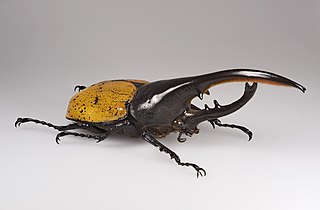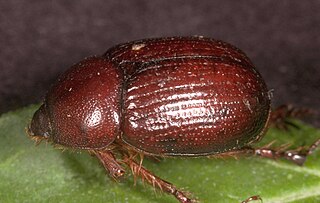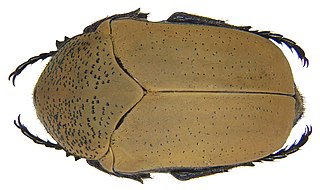
Scarabaeoidea is a superfamily of beetles, the only subgroup of the infraorder Scarabaeiformia. Around 35,000 species are placed in this superfamily and some 200 new species are described each year. Its constituent families are also undergoing revision presently, and the family list below is only preliminary.

The Hercules beetle is a species of rhinoceros beetle native to the rainforests of Central America, South America, and the Lesser Antilles. It is the longest extant species of beetle in the world, and is also one of the largest flying insects in the world.

Tomarus is a genus of scarab beetles in the subfamily Dynastinae, the rhinoceros beetles. They are native to the Americas, where they are distributed from the central United States to Argentina, and a few species occur in the Caribbean.
Megaceras briansaltini, named in honor of Brian Saltin, son of entomologist Jochen-P. Saltin, is a Peruvian rhinoceros beetle with a horn surprisingly similar to that of the character Dim from Pixar's animated film, A Bug's Life, previously unseen in nature. It remains unclear whether this is a natural feature or an uncommon mutation, as only one specimen has been found.

Ataenius is a genus of aphodiine dung beetles in the family Scarabaeidae. There are at least 290 described species in Ataenius.
Canthidium is a genus of dung beetles in the family Scarabaeidae. There are at least 170 described species in Canthidium.
Diplotaxis is a large genus of scarab beetles in the subfamily Melolonthinae. There are at least 250 described species in Diplotaxis distributed over North and Central America.
Cyclocephala is a genus of scarab beetles from the subfamily Dynastinae. Beetles of this genus occur from southeastern Canada to Argentina and the West Indies.
Cartwrightia is a genus of scarab found in Latin America. It was named and circumscribed in 1958 by Federico Islas Salas. As of 2017, three species are recognized: C. intertribalis, C. cartwrighti, and C. islasi. They can be found in the nests of leafcutter ants or in dung.

Hologymnetis is a genus of fruit and flower chafers in the family Scarabaeidae. There are about eight described species in the genus Hologymnetis.
Hemiphileurus is a genus of rhinoceros beetles in the family Scarabaeidae. There are at least 60 described species in Hemiphileurus.
Phyllophaga forsteri is a species of scarab beetle in the family Scarabaeidae. It is found in North America.

Ancognatha is a genus of rhinoceros beetles in the family Scarabaeidae. There are more than 20 described species in Ancognatha.

Phileurus is a genus of rhinoceros beetles in the family Scarabaeidae. There are more than 20 described species in Phileurus.

Dyscinetus is a genus of rice beetles in the family Scarabaeidae. There are more than 20 described species in Dyscinetus.
Archophileurus is a genus of rhinoceros beetles in the family Scarabaeidae. There are at least 30 described species in Archophileurus.
Gymnetina is a genus of fruit and flower chafers in the family of beetles known as Scarabaeidae. There are about six described species in Gymnetina.
Coscinocephalus is a genus of rhinoceros beetles in the family Scarabaeidae. There are at least two described species in Coscinocephalus.

Oryctini is a tribe of beetles in the Dynastinae.








